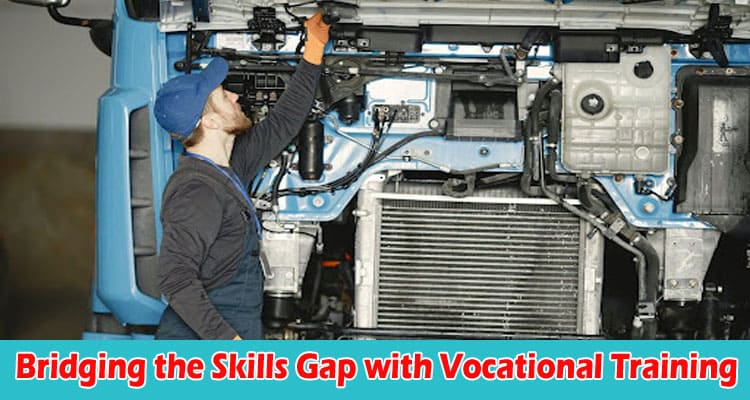In an era where the evolving workforce demands ever-more specialized skill sets, vocational training has become a cornerstone for economic development and personal advancement. Vocational education is centered around specialized training that equips individuals with the expertise necessary for a specific occupation or craft.
As industries pivot and technologies advance, a chasm has formed between the skills possessed by the current workforce and those required by employers. This gap poses a critical challenge for the global economy and job seekers. Vocational training offers a solution by providing individuals with the opportunity to acquire in-demand skills that lead to employment and career advancement.
The Rising Demand for Skilled Workers
In today’s fast-evolving employment landscape, the clamor for skilled workers across industries is at an all-time high. The rise of technology and a shift towards a more knowledge-based economy have created a significant gap between the demand for skilled labor and its supply.
This has resulted in immense opportunities for individuals with specialized skills and qualifications. As automation and artificial intelligence continue to advance, the need for uniquely human skills that machines cannot replicate grows.
Employers seek candidates with technical proficiency and those who exhibit strong interpersonal skills, problem-solving abilities, and adaptability.
One of the primary drivers of this demand is the tech industry, which is continuously looking for IT specialists, software developers, and cybersecurity experts. Yet, it’s not just the tech industry. Healthcare, renewable energy, and finance are also sectors experiencing a substantial upsurge in the need for skilled professionals.
For instance, online lending has increased in popularity in the lending industry in recent years. Therefore, online lending companies like opploans seek employees proficient in using lending software, AI, and machine learning, which is essential for their operation.
Aligning Education with Industry Requirements
Vocational training programs, such as High School CTE programs and Tech Prep Education, are a crucial link between traditional education systems and the dynamic needs of industry. These programs are designed to align closely with industry needs such as engineering and technology.
For instance, the U.S. Bureau of Labor Statistics projects that occupations related to healthcare and construction are expected to grow the fastest over the next decade.
Through the provision of specialized courses created in conjunction with industry professionals, these programs guarantee that students obtain the information and abilities that are highly sought after.
This alignment not only helps to bridge the skills gap often cited by employers but also provides students with a clearer pathway to employment opportunities post-graduation.
Further, vocational education adapts quickly to market changes, equipping students with up-to-date and relevant competencies that allow them to thrive in a constantly evolving job market.
Enhancing Job-Readiness with Practical Experience
Vocational training stands out as a cornerstone for preparing a skilled workforce these days. This education is tailored to impart practical skills and knowledge directly tied to specific trades or professions. Unlike traditional academic routes, vocational programs such as High Apprenticeship programs and On-the-job training are designed to make students job-ready upon completion.
One of the quintessential aspects of vocational training is its focus on hands-on experience. Learners are not just taught the theoretical underpinnings of a field. They are also given ample opportunity to apply these principles in real-world settings.
Such an approach is invaluable as it bridges the gap between the classroom and the workplace, allowing students to gain confidence in their abilities while they learn.
Furthermore, vocational training programs often have tight-knit connections with industries, enabling curriculum development that keeps pace with current industry standards and requirements. This strong link ensures that the skills students acquire are relevant, up-to-date, and in high demand.
A Versatile Solution for Diverse Sectors
The flexibility of vocational training means it can adapt to various sectors and rapidly evolving technologies. For example, the advent of renewable energy technologies has spurred a need for new skill sets, which vocational courses now offer.
Vocational training emerges as a beacon of practical education, equipping individuals with the specialized skills necessary to excel across various industries. It is the foundation of a capable and flexible workforce and melds theoretical knowledge and hands-on experience, creating professionals ready to hit the ground running.
Moreover, vocational courses are highly adaptable. Courses are often designed in collaboration with industry leaders, ensuring the curriculum is aligned with current market demands.
This symbiotic relationship benefits students, who gain relevant and employment-ready skills, and employers, who gain access to a pool of workers with up-to-date expertise.
Additionally, vocational training provides a pathway for lifetime learning and career advancement, which is vital for adapting to the evolving demands of various sectors.
Bridging the Gap for Non-traditional Students
Vocational training offers a lifeline to non-traditional students who seek practical skills and a swift entry into the workforce. Vocational programs recognize that success isn’t a one-size-fits-all endeavor and provide support to individuals who would not succeed in a traditional academic environment by emphasizing competency-based education.
These programs champion inclusivity by offering flexible schedules, hands-on learning, and industry-specific training that align with the needs of adults, career-changers, and those balancing education with other life commitments.
Through partnerships with local businesses and industries, vocational training keeps the curriculum relevant and targeted, ensuring that students can meet the demands of employers upon graduation.
It’s an essential bridge connecting the overlooked talents of non-traditional learners to meaningful career opportunities, fostering a diverse and skilled workforce prepared to tackle the challenges of today’s job market.
Conclusion
Vocational training is essential for preparing a competent workforce and is pivotal in driving economic growth by ensuring that the workforce’s skills resonate with evolving industry demands. By focusing on skills-based learning, countries can prepare their workers for the fast-evolving technological world and maintain a strong position in the global economy.







